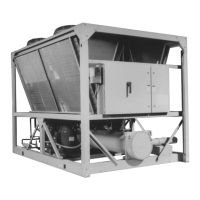JOHNSON CONTROLS
100
2.03 REFRIGERANT CIRCUIT COMPONENTS
Each refrigerant circuit shall include: liquid line shutoff
valve with charging port, low side pressure relief device,
lter-drier, solenoid valve, sight glass with moisture indi-
cator, expansion valves, and exible, closed-cell foam
insulated suction line.
2.04
HEAT EXCHANGERS
A. Evaporator:
1. Direct expansion type with refrigerant inside
h
igh efciency copper tubes, chilled liquid forced
over the tubes by galvanized steel bafes.
2. Constructed, tested, and stamped in accor-
dance with applicable sections of ASME
pressure vessel code for minimum 350 PSIG
(24 bar)refrigerant side design working pres
sure and150 PSIG (10 bar) water side design
working pressure.
3. Shell covered with ¾" (19mm), exible, closed
cell insulation, thermal conductivity of 0.26k
([BTU/HR-Ft
2
-°F]/in.) maximum. Water nozzles
with grooves for mechanical couplings, and in
sulated by Contractor after pipe installation.
4. Provide vent and drain ttings, and thermostati
cally controlled heaters to protect to -20°F
(29°C) ambient in off-cycle.
B. Air Cooled Condenser:
1. Coils: Internally enhanced, seamless copper
tubes, mechanically expanded into aluminum
alloy ns with full height collars. Subcooling coil
an integral part of condenser. Design working
pressure shall be 450 PSIG (31 bar).
2. Fans: Shall be dynamically and statically bal
anced, direct drive, corrosion resistant glass
ber reinforced composite blades molded into
a low noise, full-airfoil cross section, providing
vertical air discharge and low sound. Each fan
in its own compartment to prevent crossow
during fan cycling. Guards of heavy gauge,
PVC (polyvinylchloride) coated or galvanized
steel.
3. Fan Motors: High efciency, direct drive, 6 pole,
3 phase, insulation class “F”, current protected,
Totally Enclosed Air-Over (TEAO), rigid
mounted, with double sealed, permanently lu-
bricated, ball bearings.
2.05 CONTROLS
A. General: Automatic start, stop, operating, and pro-
tection sequences across the range of scheduled
conditions and transients.
B.
Microprocessor Enclosure: Rain and dust tight
NEMA 3R/12 (IP55) powder painted steel cabinet
with hinged, latched, and gasket sealed door.
C. Microprocessor Control Center:
1. Automatic control of compressor start/stop,
anti-coincidence and anti-recycle timers, auto-
matic pumpdown shutdown, condenser fans,
evaporator pump, evaporator heater, unit alarm
contacts, and chiller operation from 0°F to 125°F
(-18°C to 52°C) ambient. Automatic reset to
normal chiller operation after power failure.
2. Remote water temperature reset via a Pulse
Width Modulated (PWM) input signal or up to
two steps of demand (load) limiting.
3. Software stored in non-volatile memory, with
programmed setpoints retained in lithium bat-
tery backed real time clock (RTC) memory for
minimum 5 years.
4. Forty character liquid crystal display, descrip-
tions in English (or Spanish, French, Italian, or
German), numeric data in English (or Metric)
units. Sealed keypad with sections for Setpoints,
Display/Print, Entry, Unit Options & clock, and
On/Off Switch.
5. Programmable Setpoints (within Manufacturer
limits): display language; chilled liquid tempera-
ture setpoint and range, remote reset tempera-
ture range, set daily schedule/holiday for start/
stop, manual override for servicing, low and high
ambient cutouts, number of compressors, low
liquid temperature cutout, low suction pressure
cutout, high discharge pressure cutout, anti-re-
cycle timer (compressor start cycle time), and
anti-coincident timer (delay compressor
starts).
6. Display Data: Return and leaving liquid tem-
peratures, low leaving liquid temperature cut-
out setting, low ambient temperature cutout set-
ting, outdoor air temperature, English or metric
data, suction pressure cutout setting, each sys
tem suction pressure,discharge pressure (optional),
liquid temperature reset via a YORK ISN DDC
or Building Automation System (by others) via
PWM input as standard or a 4-20milliamp or 0-
10 VDC input or contact closure with optional
BAS interface, anti-recycle timer status for each
compressor, anti-coincident system start timer
condition, compressor run status, no cooling
load condition, day, date and time, daily start/
stop times, holiday status, automatic or manual
system lead/lag control, lead system denition,
Guide Specications – continued

